Method for operating an anesthesia or ventilation apparatus having a trigger function and devcie therefor
a technology of trigger function and anesthesia, which is applied in the direction of valve operation means/release devices, applications, diagnostic recording/measuring, etc., can solve the problem of reducing the drive of respiratory and respiratory functions, reducing the need for ventilation, and -dependent delay of star
- Summary
- Abstract
- Description
- Claims
- Application Information
AI Technical Summary
Benefits of technology
Problems solved by technology
Method used
Image
Examples
Embodiment Construction
[0031]In the upper portion of FIG. 1, a schematically simplified ECG trace of a ventilated patient is shown. In the ECG trace shown, three phases are illustrated and each of these phases is identified by the numerals 1 and 2. In each phase, the time point 1 identifies the time-dependent completion of the QRS-complex and time point 2 corresponds to the occurrence of the T-wave. The flow curve of the same patient is shown in the lower portion of FIG. 1 and moves about a zero line with this flow curve being synchronized to the ECG trace. A region above the zero line corresponds to the gas take up of the patient, that is, the inhalation (mechanical or spontaneous) and a region below the zero line corresponds to the gas output or the exhalation by the patient. Reference numeral 5 identifies a flow trigger threshold or trigger threshold which is temporarily set higher to avoid cardiac self-triggering each time in a region between QRS-complex and T-wave as likewise shown in FIG. 1 in order...
PUM
 Login to View More
Login to View More Abstract
Description
Claims
Application Information
 Login to View More
Login to View More - R&D
- Intellectual Property
- Life Sciences
- Materials
- Tech Scout
- Unparalleled Data Quality
- Higher Quality Content
- 60% Fewer Hallucinations
Browse by: Latest US Patents, China's latest patents, Technical Efficacy Thesaurus, Application Domain, Technology Topic, Popular Technical Reports.
© 2025 PatSnap. All rights reserved.Legal|Privacy policy|Modern Slavery Act Transparency Statement|Sitemap|About US| Contact US: help@patsnap.com



